This archived website ‘James Ensor. An online museum.’ is temporarily not being updated. Certain functionality (e.g. specific searches in the collection) may no longer be available. News updates about James Ensor will appear on vlaamsekunstcollectie.be. Questions about this website? Please contact us at info@vlaamsekunstcollectie.be.
La Boutique de Grognelet, James Ensor as theatre-maker
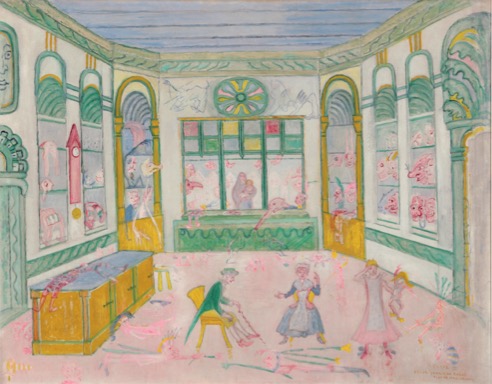
Technical file (1)
- La Boutique de Grognelet, scenery design for the first act of the ballet pantomime: La Gamme d'Amour-Flirt des Marionettes, 1912, oil painting on canvas, 92 x 116 cm
- Collection: Private collection of Mr Bart Versluys
- Provenance: Collection of Mrs Alexandra Daveluy (Ostend), Collection of Mr Jean Menzel (New York), Collection of Mr Eric Estorick (London), Knoedler & Co. (New York), Christian Fayt Art Gallery (Knokke), Collection of Mr Willy Woestijn (Knokke)
- Sales: London, Sotheby's 24.4.1963, no. 67 ‘Les Marionnettes, 1916'; Geneva, Galerie Motte, 5.12.1964, no. 46 ‘Les marionnettes, 1916'; Geneva, Galerie Motte, 26.11.1966 no. 248 ‘Les marionnettes, 1916'; London, Christie's, 1.12.1980, no. 29, New York, Sotheby's, 11.11.1987, no. 29
- References: Le Roy, p. 1963; p. 166 (ill.); Sélection, IV, no.2, November 1924, p. 156 (ill.), ‘La Gamme d'Amour 1er acte'; Hellens (ill.) ‘Décor voor een ballet', Cuypers (ill) ‘1892'; De Ridder (1930), pl. 50 (ill), Tricot X., Vandenbossche P., Hostyn N. e.a. (2010), p. 88 (ill.), Madeline L e.a. (2010), p. 37 (ill.)
- Solo exhibitions: Brussels, Palace for Fine Arts, 1929, no. 265; Ostend, Kursaal, 1931, no. 3; London, Marlborough Fine Art, 1960, no. 77; Geneva, Galerie Motte, 1966, no. 41; Knokke, Christian Fayt Art Gallery, 1978, no. 10; Brussels, KMSKB, 1999-2000, no. 162
Prologue
The talents of James Ensor are not limited to drawings, sketches and paintings. He is also an entertainer, writer, enthusiastic speaker, musician and composer. Many of these facets come together in La Gamme d'Amour, a performance piece for which he writes the screenplay, composes the music, designs the costumes and creates the sceneries. He even organises the lobbying efforts in order to perform it, with or without a stage. Music and theatre run throughout his visual oeuvre as themes. Among other things, we see fantastic musicians, scenery paintings and fanfares. In addition, his work inspires composers. (2) In La Boutique de Grognelet, Ensor steps outside of his comfort zone. He becomes a theatre-maker in praxis instead of a director on canvas.
La Gamme d'Amour - Flirt des Marionettes is a ‘ballet pantomime' that consists of 2 acts and 26 scenes. It was completed in 1911 - 1912, centred around 6 piano pieces that date from 1906 - 1911. In the period from 1910 to 1912, the characters, scenery and costumes take shape in numerous drawings. The majority of these drawings were published and collected in the lithographic folio La Gamme d'Amour (1929). (3) The paintings and the scenery designs were completed in 1912. This essay focuses upon the scenery painting from the first act: La Boutique de Grognelet. It forms a counterpart to La Place Publique (Image 6), the scenery painting for the second act. Both works share a narrative character and an elementary manner of presentation. The scenery paintings are a graphic representation of the libretto and thus form a sort of guide for the story. We cannot summarise the storyline more colourfully and comprehensively than Karel Van de Woestijne in a newspaper article from 1922.
The ‘Gamme d'Amour' is otherwise the simplest thing in the world, if one judges its screenplay. Grognelet and Brutonne manage a toy store together-a store more or less like the one Ensor inherited from his parents, a store full of strange mystery, ‘bariolé de couleurs vives et tendres' (vividly multi-coloured and charming). Something very typical: ‘deux chaises meublent La Boutique' (two chairs furnishing the Shop). With Ensor, there is only one, which is quite decrepit.... Miamia helps her parents-Miamia, greatly resembling Ensor. With the store assistants she displays the masks: it must become carnival, such is always the case with Ensor. However, along comes a gruesome man with an enormous nose, and he sets everything in disarray. Miamia pushes him to retreat. It doesn't prevent her parents, Grognelet and Brutonne, from treating her cruelly. It becomes much more serious still as a grievous beggar woman bearing sickly child appears in the display room-on Ensor's scenery as a very pretty appearance of the Virgin-the child pleads for a doll, which Miamia compassionately gives away. Miamia receives blows from her parents; to which heavy carnival music resounds: it is Fifrelin, the lover of Miamia, who heralds the folk's festival with his friends. Miamia tells him of her sorrow; Fifrelin comforts her, and there is a meeting arranged for the evening. As the hour of the tryst approaches, however, Grognelet and Brutonne intervene again threateningly. Fifrelin is a coward: he flees. Yet, Miamia flees after him.... Now the parents complain bitterly of their behaviour. The dolls, stored in drawers, then frighten them, so that they are incapacitated. The dolls hide them in a large box, and with a funeral march they place them on the counter as if on a hearse. Yet, Fifrelin and Miamia come back, hearing the moans and sighs of the parents, and free them. With as a natural consequence of forgiveness and blessings. The betrothal takes place immediately, with all possible carnival mirth. ‘Grognelet et Brutonne félicitent les futurs époux et l'orchestre entonne une dernière fois la tendre gamme d'amour. (Grognelet and Brutonne congratulate the future spouses and for one final time the orchestra plays the gentle gamme d'amour.) (K. Van de Woestijne, 1922: 435-436)
La boutique de Grognelet: A glimpse at the stage
La Boutique de Grognelet is the scenery for the first 20 of 26 scenes and is more sober in colour and content than the second scenery. The painting depicts the libretto up to scene V (Appendix 2). We see a clearly defined scene that is depicted centred in bird's-eye view according to the concept of a traditional view box. On the one hand, for a novice theatre maker such as Ensor, this is the most obvious choice at hand, while on the other, the space of a shop presents itself ideally for this concept.
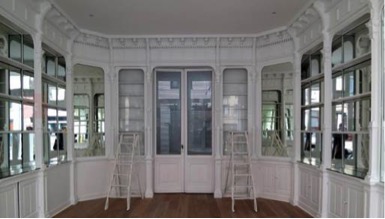
In the shop, masks, mannequins and marionettes are sold. The space is furnished with stylistic elements that mediate between art nouveau and fantasy. We see stained-glass windows, floral decorative motifs, stylised friezes and ornamental wall murals. The predominant colours are green and yellow, rendered in thin layers. (5) The characters and the displayed goods are primarily depicted in a typically Ensor white, outlined with pinkish red. The space is symmetrical: la petite porte is found directly opposite la grande porte and the built-in display cases on the right side are the mirror image of those on the left. Via the left and right wall and the prominent counter, the viewer's eye is guided to the window in the background. Here is where everything is happening: the figure with the long nose whisks away goods from the counter whereby the floor of the shop is littered with marionettes, dolls, clothing and masks. The character of the Beggar woman with the child on her arm (Ill. 2), who bears a strong resemblance to the Virgin Mary, stands behind the middle display window. Above, we see a rosette window with droll sgraffito motifs on both sides: a figure that makes the childish gesture of un pied de nez with the thumb on the nose and an animal doll with which an actor is entwined. (6) In the foreground, three of the four main characters stand: from left to right-Grognelet, Brutonne and Miamia. Fifrelin, the future husband of Miamia, already plays a role here, but is only depicted in the second scenery design.
In the story of La Gamme d'Amour, the youthful love of Fifrelin and Miamia triumphs over the brutish parental authority of Brutonne and Grognelet. Grognelet directs the hustle and bustle of the shop from atop his stool with a twisted walking stick in hand. With a menacing finger, Brutonne rebukes her daughter, who sniffling displays the doll that she wants to give to the child of the Beggar woman. In the drawings of the costume designs, the characters are represented separately or in small groups. In La Boutique de Grognelet we see the Beggar woman, Grognelet as well as Brutonne in the same clothing as in the costume design. (Ill. 2, 3 and 4). For Miamia, Ensor foresaw two costumes (Ill. 5, 6). In La Boutique de Grognelet she wears a sober outfit while in La Place Publique, she wears a colourful, fanciful dress in Polish fashion. This costume changes shows her metamorphosis from shop girl to bride.
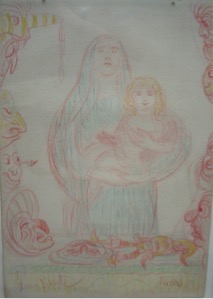
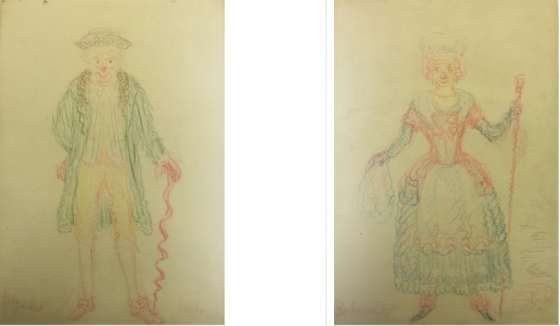
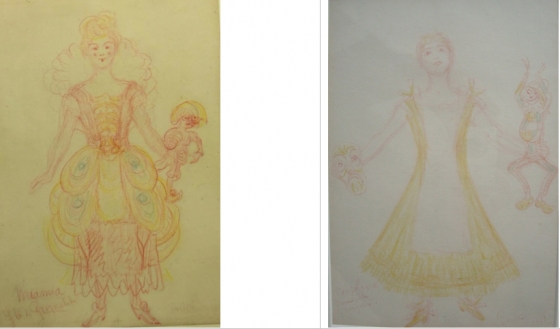
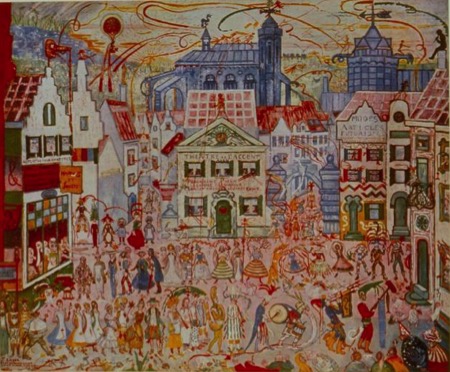
In La Place Publique the parents no longer stand in the centre, but they form a small link in the colourful entourage on the market square. They guide Miamia and Fifrelin to their wedding. A group of characters is fashioned with the greatest care and organised on the canvas. On the left side of the square we recognise the outer façade of La Boutique de Grognelet. A conspicuous detail is that Ensor depicts himself twice. Left, on the middle section, he has a red umbrella with him and he gives a doll to his confidante, Emma Lambotte. (7) He also refers to the iconic photo in which he plays the flute, above right, seated upon a mantle.
Francine Claire Legrand praises this second scenery: It is truly the apotheosis of a ballet conceived by the director (F.C. Legrand, 1993: 63). About the first scenery painting, she is rather pithy: The characters and the sceneries are fairly mawkish and do not transcend the level of the scenography (F.C. Legrand, 1993: 62). This conclusion is the consequence of a one-sided reading of the painting. The artistic value of La Boutique de Grognelet is not in the execution of detail or character setting, but rather indeed in the manner in which Ensor endeavours to broaden his craft from visual artist to that of a theatre-maker.
La Boutique de Grognelet has a documentary value for the scenery builders. This explains the deliberate, overview composition and the synthesis of the diverse narrative parts on one image plane. The image plane becomes a projection of the play's plane. What is on the canvas and where, for Ensor, seems to be at least as important as the ‘how'. Ensor departs from the space and furnishing after which he paints over with characters and merchandise. (8) The scenery designs illustrate the atmosphere and the stage props that are necessary to perform the ballet. A note within a letter to François Franck, organiser of the first production of La Gamme d'Amour, makes this clear. It is notable that after twelve years Ensor remains true to the smallest detail of the original design. The enhanced photo of La Boutique de Grognelet that is referenced in the note, takes on the function of a guide. (Appendix 1)
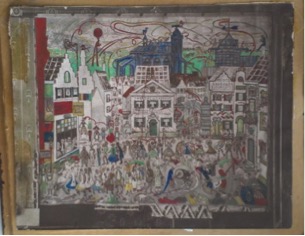

La boutique de Grognelet: A glimpse around the stage
The idea of a ballet pantomime for ‘living marionettes' sounds today like a curiosity, but was not exceptional during the cultural-historical context of the time. (9) The theme of the doll or marionette in Russia led to a number of productions that enjoyed international fame and today are a part of the art-historical repertoire. In the classical ballet The Nutcracker (Ivanov, Tchaikovsky, 1892), tin soldiers are aroused to life. Later, Meyerhold and Diaghilev, among others, couple the national folk culture with artistic renewal. Carnival and puppet theatre provide the ingredients for productions such as Carnaval (Fokine, Diaghilev, based on the music by Schumann, 1910), Petroesjka (Fokine, Stravinsky, 1911) and Parade (Massine, Satie, Picasso, Cocteau, 1916).
Within the lighter genre of performance art, the ballet pantomime became very popular in the course of the 19th century. Often characters based on commedia dell'arte played a main role. The genre was so successful because of the folk character, the relatively short duration of the performances and the combination of a simple storyline with light music. Ensor's Brussels' friend Theo Hannon wrote in 1886 the screenplay for the ballet pantomime Pierrot Macabre, set to music by Pietro Lanciani. (10)
An inspiring example for Hannon and Ensor was the French folklorist Jules Champfleury. He wrote his Pierrot pantomimes (Pierrot, valet de la mort, Pierrot perdu and Pierrot marquis) for the Parisian folk theatre and strove for entertainment above all else: (11) Ce Pierrot valet de la Mort, est une oeuvre simple comme bonjour, qui a pour but d'amuser et de faire jouir le spectateur d'un nombre illimité de coups de pied a cul et d'une myriade de soufflets. (This Pierrot, Death's assistant, is as simple a work as ‘good day', whose goal is to amuse and to make sport of a of an unlimited number of kicks to the arse and a myriad of slaps to the face.) (J. Champfleury, 1846: 4).
This citation makes it clear within which tradition we are able to situate Ensor's ballet. Although no Pierrot pantomime, the characters of La Gamme d'Amour exhibit strong resemblances to the archetypes from the commedia dell'arte. Fifrelin, whimsical and brightly coloured and Miamia, innocent and in love, are alter egos for Harlequin and Colombine. Grognelet by way of his greed and authority is a typical Pantalone figure. Sitting on a stool he orders his dilligent daughter around. He becomes angry when she gives away goods out of mercy.
When we focus more upon Ensor's direct environment, in the publication La Gamme d'Amour en de ensoriaanse muziek, Robert Wangermée refers to the setting in which Ensor abides at the end of the 19th century in Ostend. As the most important coastal city and fashionable centre, there were many wind ensembles and fanfares throughout the whole year. During the summer season there were various symphonic concerts in the Kursaal. (12) The classical repertoire was interchanged with popular fragments played from operas, waltzes and dances. Through the perusal of a Saint Cecilia catalogue from 1910, (13) an extensive summary of all available sheet music, it is striking how popular the marionette theme was. (14)
The elements of La Gamme d'Amour (carnival, music, theatre, dance and commedia dell'arte) frequently occur as theme or motif in Ensor's visual work. They exhibit a fascination for the world of the stage as a place for the performance of a reality that is outside the real world.
Pierrots and Harlequins, dancing or playing music, are the characters that populate the various romantic gardens or sentimental walks. The soft colours, flowing lines and hazy atmosphere of these works recall a bucolic beauty to mind thinking of the work of Jean Antoine Watteau (1684 - 1721). Francine Claire Legrand correctly comments that the older Ensor begins to love the winsome. (15)
The stage stands central in works such as the grand Théatre de masques (1889, Tr. 303) and Le ballet fantastique (1918, Tr. 502). (16) In addition to this, Ensor also paints ‘suggestive sceneries'. He does this, among other ways, through filling in the upper corners in arches, or allowing people, masks and animals to appear from the sides that view the central painting and are admiring (Ill. 10).
La Boutique de Grognelet distinguishes itself from the abovementioned works because of its functional and adapted character. The language of image mirrors the honest, folk atmosphere that Ensor strives for and can be labeled as ‘conscious naive'. As such, this painting forms a unity with the modest music and the simple screenplay of La Gamme d'Amour.
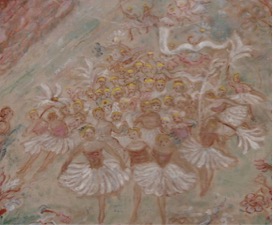
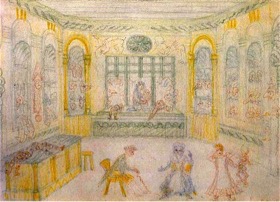
La boutique de Grognelet: A glimpse behind the stage
Under the influence of François Franck in 1924, the ballet is performed for the first time by the Royal Flemish Opera of Antwerp under the title Poppenliefde and on the basis of both scenery paintings. (17) The most logical explanation for the long period between the creation and the first performance is the outbreak of WWI and afterwards a lack of feeling and interest in a production that is grown out of and rooted in the carefree, belle époque atmosphere.
Ensor remains convinced of the quality of his project. He nutured its promotion via his own visual work (Ill. 12) and made attempts in vain to later produce his ballet by the well-known Ballet Russes of Diaghilev.
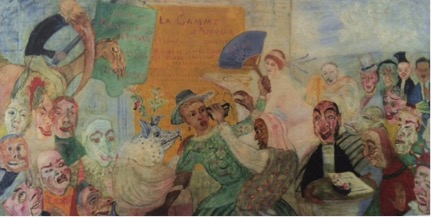
It was also not lost on contemporaries that La Gamme d'Amour did not enjoy the desired success. Karel Van de Woestijne remarked in 1922: The ballet, I say to you, has never been danced: a bitterness in Ensor's life. (K. Van de Woestijne, 1922: 433). Consequently, the question arises of why Ensor continued to have such an affinity for his Gamme d'Amour. The answer brings us to the choice of names of the characters and the development of the libretto.
In the Ensor literature, the origin of La Gamme d'Amour is situated in 1906. This date is connected to the year in which he receives a harmonium from Emma Lambotte. At the Ensor household there was, however, a piano already before, and he played at the Rousseau family home as well. Ensor composes a few stand-alone piano works that shall form the musical basis of his later ballet. While we can place the musical foundation for the ballet in 1906, the chararcters come to life already years before. For this we must go back to the letters and speeches of Ensor. The invented adjectives, proper nouns, neologisms and place names illustrate how much he gradually developed a fantastic and absurd universe.
The characters of La Gamme d'Amour have their origin in this context. In a speech from 1903, directed at Les Compagnons du Rat Mort, the carnival organisation of which Ensor was a member, and in a letter from 1902 to Ernest Rousseau, Jr., son of the art patrons Mariette and Ernest Rousseau, characters such as Murmuramis, Corylopsis, Ombrose, Turluttue, Chandelette, Olyandre and Gali-Gali are already named. (18)
With respect to the libretto, there are various autobiographical elements to be found. It is known Ensor grew up in a shop and his preference for masks, masquerades and jokes, with the annual high point being the carnival period and procession. We can also ascertain from numerous letters and references in his works that there was a dominant parental authority that often was linked to the shop. In a letter to Pol De Mont, Ensor writes in 1899: Je suis toujours extrêmement occupé en été � Ostende et dois négliger l'art pour aider ma mère qui tient un magasin de coquillages et curiosités de la mer. (I am constantly extremely busy in Summer in Ostend and must neglect art in order to help my mother who maintains a shop of shells and curiosities of the sea.) (19) Laurence Madeline also emphasises in her essay, A Ostende, le ‘tout-monde' de James Ensor, the insoluble relationship between Ensor, his art, the shop and his family (20)
The deeper content of the libretto conceals possible personal dramas from Ensor's life. Miamia is maligned and beaten (scene VII). In the following scene, musicians and the strange, costumed and cheeful Fifrelin appears. He comforts her and they dance a spinning waltz that lovingly unfolds (scene IX). When Fifrelin returns in the evening, they are threatened by Grognelet and Brutonne upon which the lover's couple flees (scene XIV). The parents are taken away by the marionettes in ‘boxes'. Miamia and Fifrelin free the parents, whereupon they show their regret and a wedding is arranged (scene XX).
On two occasions James Ensor shall experience a similar scenario with his sister in a leading role. In the unpublished letters of Ensor to Mariette Rousseau, he describes how the romance between his sister and the Chinese Alfred Taen-Hee-Tseu ran its course. The Chinaman is un mandarin en costume merveilleux (a Mandarin man in a marvellous outfit) who only wishes to exchange it for a western outfit after urgings. He is accompanied by the police, and a colourful processession of boisterous people departs from the station to their home. On 31 August 1892, the couple marries and they travel to Berlin where he had his business. One year later, in 1893, a divorce already ensues. Just before the birth of their daughter Alexandrine on 26 March 1893, Mitche is already back in Ostend. Ensor took the long and arduous divorce process deeply to heart.
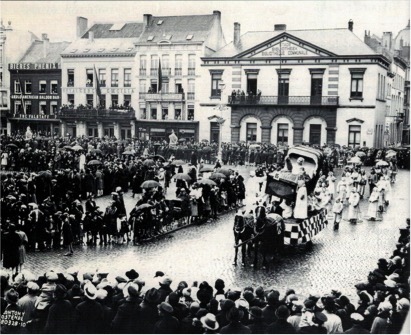
In 1908, a new family drama emerges in which Ensor was dragged along hither and thither. Alexandrine Jeanne Taen-Hee-Tseu (Ostend, 26 March-19 June 1966), daughter of Mitche, marries on 26 Septemper, at the age of 15, hastily with an ‘undesirable party', the 24 year-old Richard Daveluy. Along with her mother, they all three flee from the parental home where they had resided up to that time. On 17 July 1909, their son, Jules-Jacques, is born. They travel to Dresden and Liège in search of work, but a permanent lack of funds forces them to return to Ostend. After such drama and bitterness, Ensor shall reconcile with them again. He shall support (financially) his niece his whole life. (21)
In this libretto, we can read a combination of the two dramas. The marriage with the exotically clothed Fifrelin stands for ‘the Chinaman', who comes to ask Ensor's sister to marry in Ostend under a commodious fashion and in traditional apparel. The flight of Fifrelin and Miamia and the fortuitous result stands for Ensor's sister and niece that return to the parental homestead after their wanderings.
La boutique de Grognelet: Epilogue
A critical account of La Gamme d'Amour seemed necessary in order to explain the interpretive context of La Boutique de Grognelet. The scenery of the painting then again provided insight into the scenographic context of La Gamme d'Amour.
The painting adheres to the series of ‘scenery works' that are extensively present in the oeuvre of Ensor. Stage, theatre and attributes such as marionettes and masks particularly fascinate him. Just as with the masks, the theatre can show a tranche de vie that is not happily shown, which can be painful or must remain concealed. (22) La Boutique de Grognelet is the endpoint of a creative process of which we have recovered the origin being in 1902. Ensor composed various musical pieces at this time that were performed individually. (23) Around 1910, when he groups all of the musical pieces together and begins the creation of the libretto, at first glance he allows himself to be inspired by popular culture. A more attentive reading, however, brings out various autobiographical elements. These aspects are characteristic of Ensor's oeuvre and are developed through the years. La Gamme d'Amour can therefore be viewed as a life's work that Ensor shall cherish to the end of his life. It receives the status of a lifesong that is performed on the occasions of homages or exhibitions. Ensor gladly allows this all to happen. As such, numerous journalists who visited his studio are treated to a melody from his ballet. (24)
La Boutique de Grognelet is a testament to Ensor the storyteller and the multi-talented artist. It tells a universal story of love with text, music and image via a marionette play. At the same time, one sees through the work right into the soul of the human Ensor. Intervening life events where he was the victim are converted into a colourful, simplistic fantasy world of which he is the creator and director.
La Boutique de Grognelet is a unique painting within his oeuvre. It is unique because it combines the qualities of artistic work and documentary references. On a content level, this work confirms an important Ensorian source of inspiration, his own biography.
Footnotes
(1) TRICOT X. (2009), pp. 345-346.
(2) In 1931, Flor Alpaerts composes the James Ensor suite, based upon 4 works by Ensor.
(3) The folio is published by Georges Vriamont and bundles the 21 figure lithographs with 43 characters with ‘scenario', musical score and a reproduction of the painting for the second act.
(4) Photo: www.arsene.org/ Unfortunately there are no photos available of the interior of the Ensor-Haegheman family shop. It is thus not possible to determine to what extent Ensor was inspired by his direct environment. Personal communication with Katherine Ennekens, heritage specialist affiliated with vzw arsène (email, 24/08/2016).
(5) Zerlina Van Bella notes that the basis colours of the costume designs (red, blue, yellow, green) are carried over to the two scenery designs (VAN BELLE Z. 2014-2015, p. 8).
(6) Un pied de nez is the childish gesture whereby the thumb is held against the nose in order to direct mockery at someone. This gesture is also portrayed in Ensor's illustrations by a volume of poetry by Mallarmé (1923) and in the painting Confrontation (1934-1935).
(7) Ensor appears to be making a play upon his own libretto in which Miamia hands over a doll to the Beggar woman.
(8) We see, for example, clearly through the green line of the floorspace the face of Miamia and the doll that she holds.
(9) A ballet pantomime is a ballet without song or text. The pantomime is today a form of expression that is today nearly lost to oblivion whereby a rythmic sequence of postures and expressions, character and emotions of characters is rendered. In the first place, developed apart from dance, the pantomime was integrated into ballet beginning in 1850 under the influence of a broader interest in exotic cultures and the national folk culture. (KRISTEIN L, 1971, p. 26).
(10) Pietro Lanciani was an Italian pianist, director and composer, who in addition to numerous compositions in the variété genre also was the second director of the Casino Kursaal in Ostend. He helped Ensor with the writing of his first piano pieces in 1906, the later basis for La Gamme d'Amour.
(11) Bart Verschaffel indicates already in his article (Siffler les vices et les laideurs de la civilisation...Het groteske oeuvre van James Ensor en de Encyclopédie de la caricature van Jules Champfleury) the importance of Champfleury as a primary source of inspiration for Ensor's visual work. (VERSCHAFFEL B., 2016, pp. 14-21).
(12) WANGERMEE R., 1999, p. 54-55.
(13) MENNESON E., 1910.
(14) A work within this theme that with respect to popularity stood out was Charles Gounods Marche funèbre d'une marionette. In August of 1880, Gounod visits Ostend and this work is produced. The local paper L'Echo d'Ostende publishes an extensive report on this. (S.e, 1880, p.2).
(15) LEGRAND F.-C., 1993, p. 67.
(16) The stylistic difference in these works is great and illustrates the duality of Ensor who paints complex academic works as well as works in which he champions the folk and naive style.
(17) In 1920, La Gamme d'Amour is performed for the first time in full as a musical piece by Galerie Georges Giroux in Brussels.
(18) Example 1: 'Au revoir, brave chien marin. Le maître te salue. Giant du Froussis de la houle cinglante dit Murmuramis ou James.' (Letter Ensor-E. Rousseau 04/03/1902, KMSK Brussels collection, gifted by Mrs Wodon).
Example 2: 'Déplorons l'absence de nos amies et regrettons les beautés féminines � l'écu mignon, rates ou chevalières attachées � ces messieurs; citons: Corylopsis et Ombreuse son amie, Turlutute portant sur son écu une solive d'azur, Chandelette faisant trente six culbutes, Olyandre, syrène tachetée, pate, pataugeant dans une mer d'huile et portant sur l'écu un cygne louche, Gali-Gali reine des turquoises, (...) salveur. Murmuramis de Purluvesse, son souffle nous renver (...)' (James Ensor, Discours en noble languaige de chevalerie, 02/05/1903, p. 1-2.)
(19) James Ensor, letter to Pol De Mont, 25/09/1899.
(20) MADELINE L., 2009, p. 34.
(21) HOSTYN R., 2010, p. 126.
(22) Stéphanie Moris worked out from the perspective of psychoanalysis this presentation further of music (and theatre) as a curative and ordering power for Ensor in her book Miousic (2105).
(23) For example, Enlacements, valse was premiered in 1907 in the Kursaal of Ostend under the direction of Lanciani.
(24) Example 1: 'Fleischmann demande au grande peintre de se remettre � l'harmonium et de nous donner la berceuse qui est extraite de la Gamme d'Amour' (s.n., 1934,p.2).
Example 2: 'Ce qui nous amène � parler du ballet La Gamme d'Amour et du succès que l'oeuvre a obtenu � Liège: bientôt sur les touches d'ivoire de l'harmonium effleurées avec delicatesse par le peintre naissent les mélodies sautillantes de ce ballet plein d'entrain.' (JEP, 1928,p.2).
Bibliography
CHAMPFLEURY J., Pierrot valet de la mort, pantomime en sept tableaux, Imprimerie de gerdes, Paris, 1846.
ENSOR J., ‘Discours en noble languaige de chevalerie, composé par Missire James Ensor, franc chevalier, pour célébrer les écus, blasons et devises de nostre joyeuse Compagnie du Rat Mort, � l'occasion d'une manifestation organisée par la dite. Compagnie � Ostende, le 2 de May 1903' in: Les Ecus, A James Ensor, chevalier de l'ordre de léopold, imprimerie & lithographie artistique Geo Daveluy, Ostend, 1903.
ENSOR J., Letter to François Franck, 20/08/1923.
ENSOR J., Letter to Ernest Rousseau, 4/03/1902, KMSKB collection.
ENSOR J., Letter to Pol De Mont, 25/09/1899.
ENSOR J., Miousic [manuscript], s.d..
FLORIZOONE P. and W COPPEJANS, ‘Confrontation, James Ensor between avant-garde and tradition' in: James Ensor an online museum, Flemis Art Collection, 2016.
FLORIZOONE P., De ‘Riches Heures' van James Ensor, Illustraties bij de gedichten van Stéphane Mallarmé, Brussels, Antiquariaat F.L. Tulkens, 1998.
GOYENS DE HEUSCH S., L'invitation au voyage, la musique au XX et � la Libre Esthétique, édtion foundation pour l'Art Belge, Brussels, 1990.
HOSTYN N., ‘De familie van James Ensor' in: Bij Ensor op bezoek [exhibition catalogue], Ostend, Mu.Zee, 13/02 - 29/08/2010, Brasschaat, Pandora Publishers, 2010, pp. 117-136.
JEP, ‘James Ensor et l'embellissement d'Ostende' in: La saison d'Ostende et du littoral, 5/08/1928, yp. 52, no. 13, p. 2.
KIRSTEIN L., Mouvement and metaphor, Four centuries of ballet, New York Pitman Publishing, 1971
LEGRAND F.C, ‘Het schimmentheater' in: Ensor, naargeestig en charmant,. Antwerp, Mercatorfonds, 1993, pp. 61-70.
LE ROY G., James Ensor, Brussels, G. Van Oest & Cie, 1922.
MADELINE L., ‘A Ostende, le ‘tout-monde' de James Ensor' in: MADELINE L. et al., James Ensor [exhibition catalogue], New York, MoMA 28/06/2009-21/09/2009 and Paris, Musée d'Orsay, 20/10/2009-4/02/2010, pp. 34-39.
MENNESON E., Catalogue général de musique � Saint Cécile, Fortin E., 1910.
MORIS S., James Ensor: Miousic!, Collection La muette, Brussels, Lormont, 2015.
S.e., ‘Ensor devant le micro' in: Le Phare, 15/08/1934, jg. 2, no. 33, p. 2.
S.e., ‘Chronique des Bains' in: L'Echo d'Ostende, 12/08/1880, jg. 16, p. 2.
TODTS H., ‘James Ensor as Musician' in: James Ensor an online museum, Flemish Art Collection, s.d..
TRICOT X., James Ensor: Leven en werk, oeuvrecatalogus van de schilderijen, Mercatorfonds/Pandora, Brussel, 2009.
VAN BELLE Z., Een primair onderzoek naar de theaterkostuum - en decorontwerpen van James Ensor voor zijn ballet-pantomime ‘La Gamme d'Amour' (1910-1914), [Master's Thesis Art History, KU Leuven, Faculty of Arts], 2014-2015.
VAN DE WOESTIJNE K., ‘De week van James Ensor IV' in: Nieuwe Rotterdamsche Courant, 25/08/1922.
VERSCHAFFEL B., 'Siffler les vices et les laideurs de la civilisation...' - ‘Het groteske oeuvre van James Ensor en de Encyclopédie de la caricature van Jules Champfleury' in: De Witte Raaf, May - June 2016, no. 181, pp. 14-21.
WANGERMEE R., ‘La Gamme d'amour en de Ensoriaanse muziek' in: Ensor, Brussels, KMSKB, 1999, pp. 54-62.
APPENDIX 1
Letter by James Ensor to François Franck (August 20, 1923)
LA GAMME D'AMOUR (FLIRT DES MARIONETTES) BALLET DECORS COSTUMES ET MUSIQUE DE J.ENSOR: NOTES EXPLICATIVES
Un boutique bariolé de couleurs vives et tendres, au fond et face au public une large vitrine où des masques, des poupées et des pantins marient leurs accents pittoresques. A droite une grande porte donne sur une rue, � gauche une petite porte. A la grande porte sonnent des clochettes.A gauche un grand comptoir fermé contient des pantins et des marionettes. Aux murs et � la vitrine pendent des masques et des vêtements carnavalesques. 2 chaises meublent La Boutique. La grande vitrine du fond donne sur une place publique.
La Photo rehausseé de couleurs représente fidèlement le décor du premier tableau. Boutique de jouets, masques, etc. La partie centrale du fond de la scène représente une vitrine � devanture ouverte. Par l'ouverture de cette vitrine on aperçoit des maisons blanches � pignons (maisons peinte sur une toile placée � quelques distance de la vitrine) Les personnages: mendiante, masques pourront circuler et evoluer avec facilité entre la vitrine-devanture, et les maisons � pignons du fond de la scène. Les masques passent et repassent et surtout regardent curieusement du dehors, inquiéterons les demoiselles de boutique et ajouteront � l'intéret de la scène. Surtout 'le masque au long nez', balayant de son nez énorme les marionnettes, jouets et patins de l'étalage pour les jeter sur le sol du boutique. (scène 1)
A la droite du spectateur la grande porte d'entrée est garnie de clochettes. Les fillettes et les autres personnages (scène 3, etc.) en entrant en scène font tinter les clochettes, cette jolie scène pourrait donner un effet musical inattendu et curieux. De cette grande port débouchent tous les personnages du ballet sauf Grognelet et Brutonne (scène 1, etc.) et les pantins les jouets et les marionettes. (scène 16)
A la gauche du spectateur la petite porte sert uniquement � 'arrivé et au départ de Grognelet et de Brutonne (scènes 1,6,7, 14) et � l'arrivée des marionettes de pantins et des jouets (scène 16) et au départ des marionettes des pantins et des jouets (scène 19).
ACCESSOIRES
Un comptoir de grande dimension, non vitré aux portes fermés au loyet(?); les demoiselles en retirent les marionettes et les pantins (scène 2).Le comptoir placé � la gauche du spectateur contiendra des pantins, des jouets, des marionettes; derrière le comptoir seront caché les personnages vivants représentant des marionettes, des jouets et des pantins (scène 16).
La photgraphie rehaussée du premier tableau représente fidèlement le comptoir et son emplacement. Pour garnir La Boutique et les niches du décor du 1 tableau, les masques ordinaires de nos caranavals de reu suffiront en grande partie et donneront grand effet. Au reste les masques les plus caractéristiques seront les plus beaux.
APPENDIX 2
Libretto from the lithographic folio La Gamme d'Amour, 1929, Georges Vriamont, pp 6-7.
The scenes below are pictured in La Boutique de Grognelet (scenes 1 till 5).
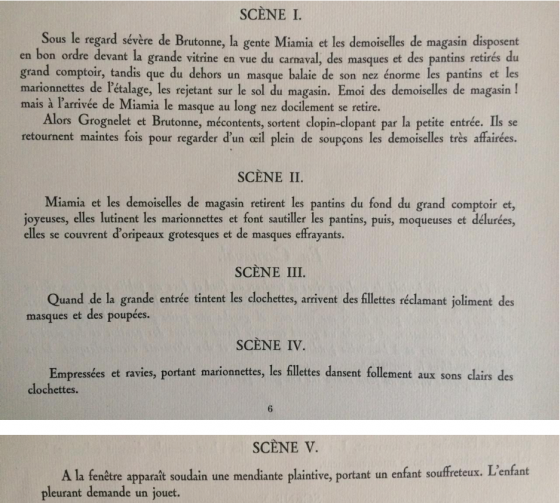
Patrick Florizoone en Willem Coppejans







